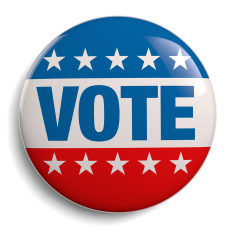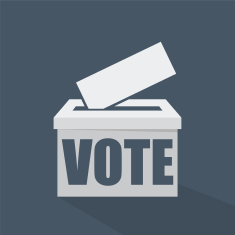We have an election here in the United States in which both major parties have now nominated very unpopular Presidential candidates. A Data Targeting poll in May showed that 65% would be “at least somewhat, pretty or very willing to support a candidate for President who is not Donald Trump or Hillary Clinton.” A Gallup Poll last September found that 60% thought a third party was needed. Dissatisfaction with the present two-party system is at an all-time high.
 This is causing much dialogue about whether to vote for a third party or whether you need to vote for the major party candidate you least dislike because of the threat of election of the other major party candidate on the theory that third party votes hurt your second choice candidate. My contention is that your view on this may be very different depending on whether you are looking at it from a short-range perspective – generally one based only on this election – or a long-range perspective.
This is causing much dialogue about whether to vote for a third party or whether you need to vote for the major party candidate you least dislike because of the threat of election of the other major party candidate on the theory that third party votes hurt your second choice candidate. My contention is that your view on this may be very different depending on whether you are looking at it from a short-range perspective – generally one based only on this election – or a long-range perspective.
Why do we have a two-party system? Well the crux of it is what has been called Duverger’s Law. Duverger’s law is a principle which states that plurality-rule elections structured within single-member districts tend to favor a two-party system. The reason is that voting for a relatively weak party creates the possibility that a major party will win without a majority of the vote, and it is likely to be the party most disliked by the voters for that relatively weak party. Based on this logic, many voters will engage in “lesser evil” voting in which they will not vote for the candidate they most agree with if s/he is a third-party candidate but instead for whichever one of the major party candidates they find less distasteful. The result is an enormous barrier to the rise of new parties.
The U.S. Constitution did not establish a two-party system or a party system at all, nor did it establish plurality voting. It mostly leaves elections up to the states. Most states (but not all) have a system in which the candidate with the most votes, no matter how small a percentage of the total vote that is, wins. This has greatly favored our present two-party system.
The President is chosen by an indirect means called the Electoral College. The details of how it works are not specified in the Constitution, but are a matter of federal statute. Unlike the case in most American elections, a majority vote is required in the Electoral College. So if there were multiple candidates with electoral votes and none had an initial majority, the electors would need to negotiate among themselves to come to a majority agreement on whom to elect, and the President and Vice President elected would not have to be from the same party. This is somewhat similar to parliamentary systems in many countries, where multiple parties negotiate to select a government. If the Electoral College deadlocks, the House (voting by state delegation) chooses the President and the Senate the Vice President. So it is not federal requirements which produce the two-party system.
In our country, politics is generally looked at from a short-range perspective – the impact of the current election. When looked at from this perspective, the lesser-evil approach seems reasonable. [Even here, the thinking is often myopic and subject to debate. Many of my friends on the left maintain that a vote for Jill Stein of the Green Party amounts to a vote for Donald Trump. But they are generally not considering that there are three third parties which will be on most state ballots, and the other two – Libertarian and Constitution – appeal more to people who would otherwise vote Republican. The effect of voting for alternative candidates is very uncertain.]
Most of these people agree a change in the system is needed. However, they say first we need to deal with this election. This happens every election. Mañana never comes with this short-range thinking. In theory, we can work for changes in election processes while continuing to operate under the two-party system but the likelihood of success is very small. In the first place, you can’t get the momentum needed for such a major change. Secondly, the change is not in the interests of the two parties favored by the current system so why should they allow a change?
Meaningful social change usually is a process which takes some time. It needs long-range thinking in order to succeed. And it absolutely requires the taking of risks. There is no risk-free social change process. And it normally involves efforts to actually implement what change you can without official governmental action. It also acknowledges that making the negative effects of the current system more obvious to the masses is usually key to getting large-scale popular support for change.
So how would we approach the election from a long-term social change oriented point of view? In the first place, we would be more willing to accept short-term risk. For example, would voting for Jill Stein make the election of Donald Trump more likely than if we voted for Hillary Clinton? We don’t really know, but we have to accept the risk that this might be the case if we want change in the long-term. Otherwise, the system won’t change. But if it was seen that the current system created a mess when there were four or five parties getting significant numbers of votes, there would be a great impetus to change the system to better accommodate multiple parties.
From a long-term social change oriented point of view, we vote for a candidate who for the most part expresses our beliefs without being too concerned about the overall results of this particular election. The more votes there are for third parties the more the possibility of a multi-party system becomes evident and the more the problems of the current system become evident. There arises greater awareness of the possibility of using a different system, and greater awareness of the flaws in the current system.
 If the number of votes for third parties (not just for the Presidency – the Green and Libertarian Parties are running many candidates for Congress as well as state and local offices) rises substantially over what has historically been the norm (and the level of current dissatisfaction with the major parties makes that a realistic possibility), we begin to enter a new situation. If candidates who are clearly opposed by the majority of voters are being elected, dissatisfaction will rise and momentum will be created for a more democratic system such as instant runoff or some other system requiring eventual majority consent. In our system, the changes will probably come state by state over a long period of time. A Constitutional change (which is not required to get away from a two-party system, but might have some merit), if it comes at all, would not come until that process was well under way. But long-term change would become much more possible, and we could get rid of the “lesser evil” dilemma.
If the number of votes for third parties (not just for the Presidency – the Green and Libertarian Parties are running many candidates for Congress as well as state and local offices) rises substantially over what has historically been the norm (and the level of current dissatisfaction with the major parties makes that a realistic possibility), we begin to enter a new situation. If candidates who are clearly opposed by the majority of voters are being elected, dissatisfaction will rise and momentum will be created for a more democratic system such as instant runoff or some other system requiring eventual majority consent. In our system, the changes will probably come state by state over a long period of time. A Constitutional change (which is not required to get away from a two-party system, but might have some merit), if it comes at all, would not come until that process was well under way. But long-term change would become much more possible, and we could get rid of the “lesser evil” dilemma.
Most countries find that it is the third parties which become the engine for meaningful social change. Even in this country, that has happened with the election of third party candidate Abraham Lincoln. Once we move to a multi-party system, like most democratic republics have, there will be greater opportunities for all sorts of social change to move forward in our political system.
So how can you exhibit long-range, social change oriented, thinking in this year’s elections? Vote for the candidates which best represent your values. Don’t vote out of fear of possible unintended consequences of your conscience-based votes. Vote your hopes, not your fears. Don’t despair of the possibility of change, but recognize that it won’t occur overnight.